Countdown: Leadership and Management in Business Sustainability Report
VerifiedAdded on 2023/04/24
|22
|5379
|423
Report
AI Summary
This report examines Countdown's business sustainability, focusing on leadership and management practices. It analyzes the application of life cycle thinking and the quadruple bottom line approach within the organization, highlighting both strengths and areas for improvement. The study identifies opportunities for innovation, such as incorporating sustainable materials and reducing waste, while also acknowledging challenges like market competition and the open economy. A risk management analysis is conducted, identifying potential risks in financial, customer, internal, and learning and growth aspects, along with strategies to mitigate these risks. The report concludes by emphasizing the importance of innovation and a purpose-driven approach to enhance Countdown's sustainability and market position.
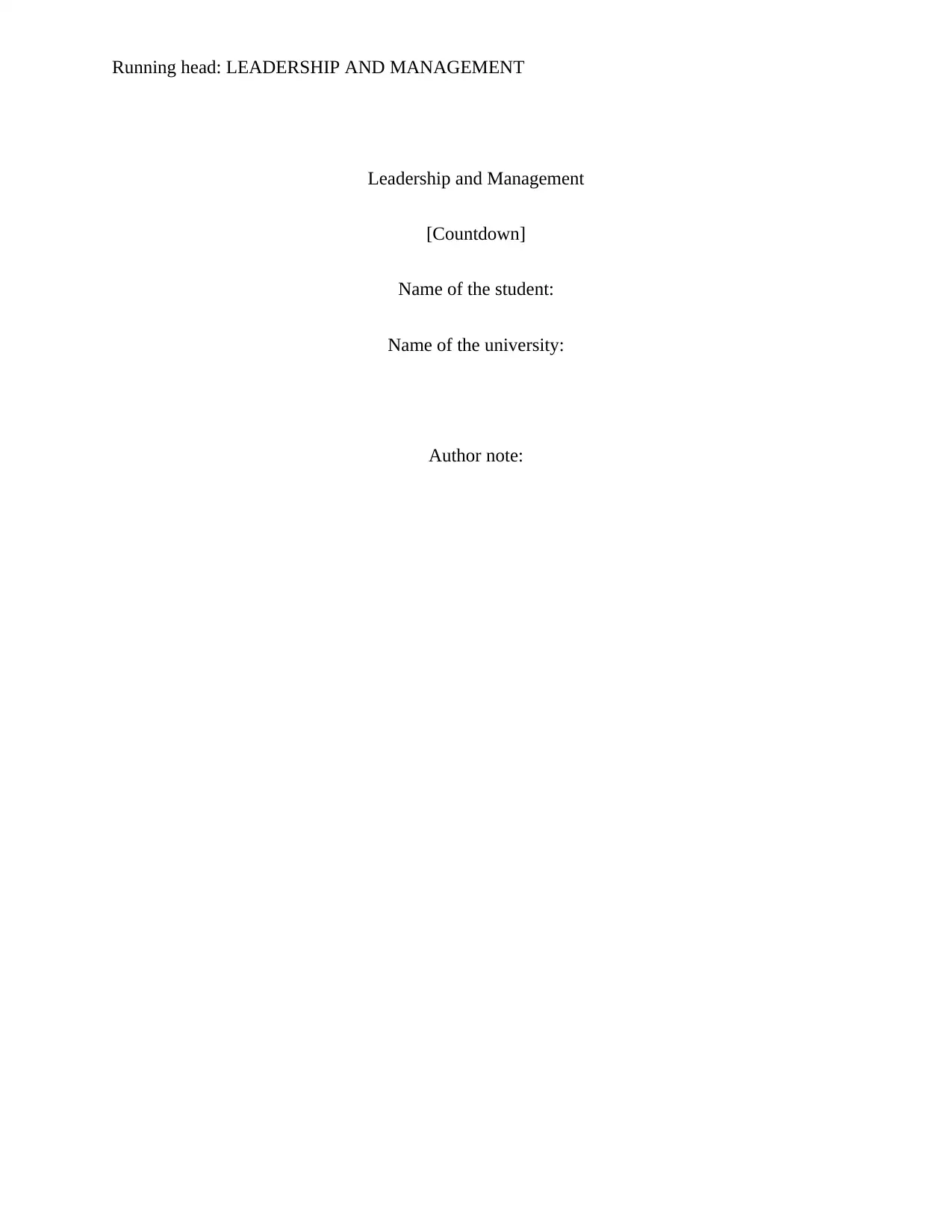
Running head: LEADERSHIP AND MANAGEMENT
Leadership and Management
[Countdown]
Name of the student:
Name of the university:
Author note:
Leadership and Management
[Countdown]
Name of the student:
Name of the university:
Author note:
Paraphrase This Document
Need a fresh take? Get an instant paraphrase of this document with our AI Paraphraser
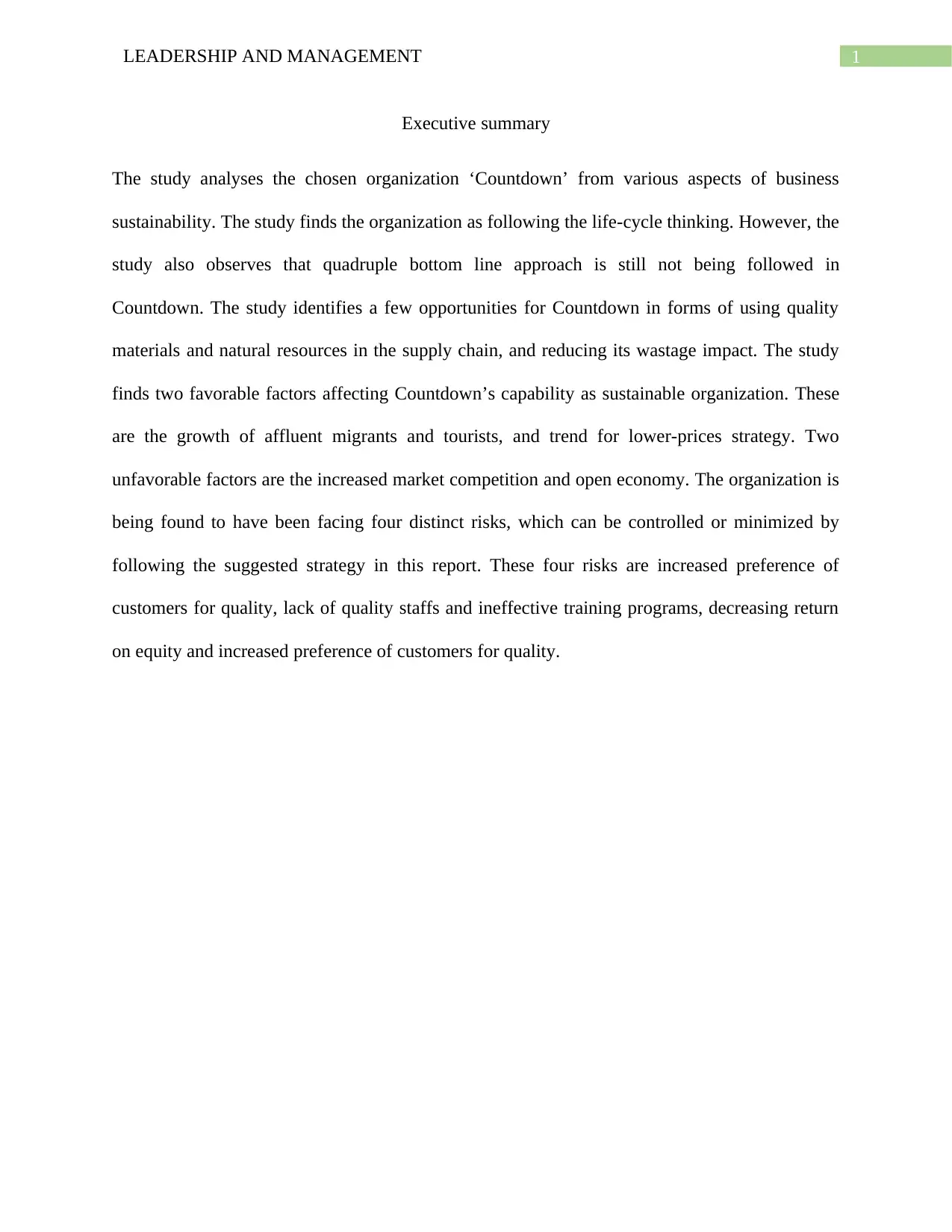
1LEADERSHIP AND MANAGEMENT
Executive summary
The study analyses the chosen organization ‘Countdown’ from various aspects of business
sustainability. The study finds the organization as following the life-cycle thinking. However, the
study also observes that quadruple bottom line approach is still not being followed in
Countdown. The study identifies a few opportunities for Countdown in forms of using quality
materials and natural resources in the supply chain, and reducing its wastage impact. The study
finds two favorable factors affecting Countdown’s capability as sustainable organization. These
are the growth of affluent migrants and tourists, and trend for lower-prices strategy. Two
unfavorable factors are the increased market competition and open economy. The organization is
being found to have been facing four distinct risks, which can be controlled or minimized by
following the suggested strategy in this report. These four risks are increased preference of
customers for quality, lack of quality staffs and ineffective training programs, decreasing return
on equity and increased preference of customers for quality.
Executive summary
The study analyses the chosen organization ‘Countdown’ from various aspects of business
sustainability. The study finds the organization as following the life-cycle thinking. However, the
study also observes that quadruple bottom line approach is still not being followed in
Countdown. The study identifies a few opportunities for Countdown in forms of using quality
materials and natural resources in the supply chain, and reducing its wastage impact. The study
finds two favorable factors affecting Countdown’s capability as sustainable organization. These
are the growth of affluent migrants and tourists, and trend for lower-prices strategy. Two
unfavorable factors are the increased market competition and open economy. The organization is
being found to have been facing four distinct risks, which can be controlled or minimized by
following the suggested strategy in this report. These four risks are increased preference of
customers for quality, lack of quality staffs and ineffective training programs, decreasing return
on equity and increased preference of customers for quality.
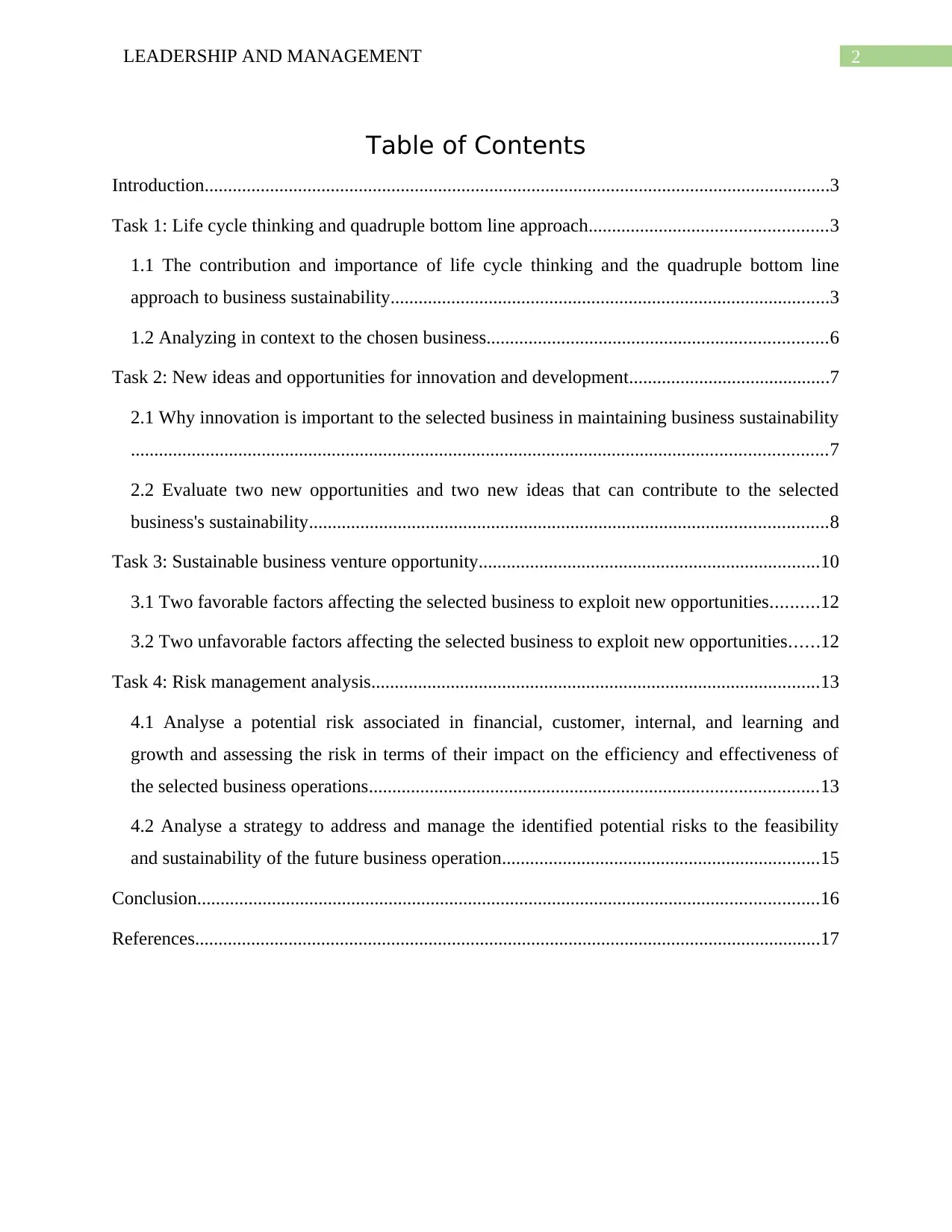
2LEADERSHIP AND MANAGEMENT
Table of Contents
Introduction......................................................................................................................................3
Task 1: Life cycle thinking and quadruple bottom line approach...................................................3
1.1 The contribution and importance of life cycle thinking and the quadruple bottom line
approach to business sustainability..............................................................................................3
1.2 Analyzing in context to the chosen business.........................................................................6
Task 2: New ideas and opportunities for innovation and development...........................................7
2.1 Why innovation is important to the selected business in maintaining business sustainability
.....................................................................................................................................................7
2.2 Evaluate two new opportunities and two new ideas that can contribute to the selected
business's sustainability...............................................................................................................8
Task 3: Sustainable business venture opportunity.........................................................................10
3.1 Two favorable factors affecting the selected business to exploit new opportunities..........12
3.2 Two unfavorable factors affecting the selected business to exploit new opportunities......12
Task 4: Risk management analysis................................................................................................13
4.1 Analyse a potential risk associated in financial, customer, internal, and learning and
growth and assessing the risk in terms of their impact on the efficiency and effectiveness of
the selected business operations................................................................................................13
4.2 Analyse a strategy to address and manage the identified potential risks to the feasibility
and sustainability of the future business operation....................................................................15
Conclusion.....................................................................................................................................16
References......................................................................................................................................17
Table of Contents
Introduction......................................................................................................................................3
Task 1: Life cycle thinking and quadruple bottom line approach...................................................3
1.1 The contribution and importance of life cycle thinking and the quadruple bottom line
approach to business sustainability..............................................................................................3
1.2 Analyzing in context to the chosen business.........................................................................6
Task 2: New ideas and opportunities for innovation and development...........................................7
2.1 Why innovation is important to the selected business in maintaining business sustainability
.....................................................................................................................................................7
2.2 Evaluate two new opportunities and two new ideas that can contribute to the selected
business's sustainability...............................................................................................................8
Task 3: Sustainable business venture opportunity.........................................................................10
3.1 Two favorable factors affecting the selected business to exploit new opportunities..........12
3.2 Two unfavorable factors affecting the selected business to exploit new opportunities......12
Task 4: Risk management analysis................................................................................................13
4.1 Analyse a potential risk associated in financial, customer, internal, and learning and
growth and assessing the risk in terms of their impact on the efficiency and effectiveness of
the selected business operations................................................................................................13
4.2 Analyse a strategy to address and manage the identified potential risks to the feasibility
and sustainability of the future business operation....................................................................15
Conclusion.....................................................................................................................................16
References......................................................................................................................................17
⊘ This is a preview!⊘
Do you want full access?
Subscribe today to unlock all pages.

Trusted by 1+ million students worldwide
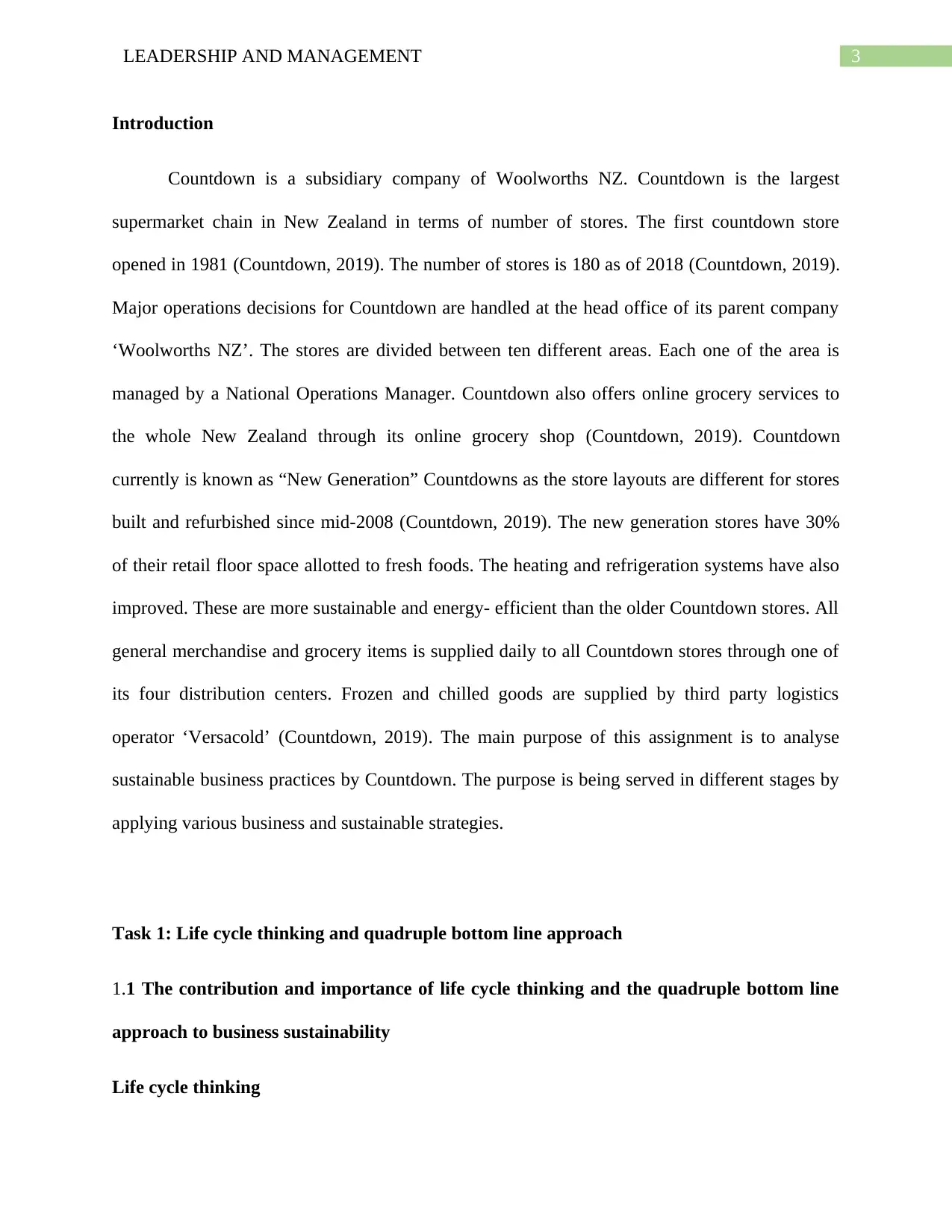
3LEADERSHIP AND MANAGEMENT
Introduction
Countdown is a subsidiary company of Woolworths NZ. Countdown is the largest
supermarket chain in New Zealand in terms of number of stores. The first countdown store
opened in 1981 (Countdown, 2019). The number of stores is 180 as of 2018 (Countdown, 2019).
Major operations decisions for Countdown are handled at the head office of its parent company
‘Woolworths NZ’. The stores are divided between ten different areas. Each one of the area is
managed by a National Operations Manager. Countdown also offers online grocery services to
the whole New Zealand through its online grocery shop (Countdown, 2019). Countdown
currently is known as “New Generation” Countdowns as the store layouts are different for stores
built and refurbished since mid-2008 (Countdown, 2019). The new generation stores have 30%
of their retail floor space allotted to fresh foods. The heating and refrigeration systems have also
improved. These are more sustainable and energy- efficient than the older Countdown stores. All
general merchandise and grocery items is supplied daily to all Countdown stores through one of
its four distribution centers. Frozen and chilled goods are supplied by third party logistics
operator ‘Versacold’ (Countdown, 2019). The main purpose of this assignment is to analyse
sustainable business practices by Countdown. The purpose is being served in different stages by
applying various business and sustainable strategies.
Task 1: Life cycle thinking and quadruple bottom line approach
1.1 The contribution and importance of life cycle thinking and the quadruple bottom line
approach to business sustainability
Life cycle thinking
Introduction
Countdown is a subsidiary company of Woolworths NZ. Countdown is the largest
supermarket chain in New Zealand in terms of number of stores. The first countdown store
opened in 1981 (Countdown, 2019). The number of stores is 180 as of 2018 (Countdown, 2019).
Major operations decisions for Countdown are handled at the head office of its parent company
‘Woolworths NZ’. The stores are divided between ten different areas. Each one of the area is
managed by a National Operations Manager. Countdown also offers online grocery services to
the whole New Zealand through its online grocery shop (Countdown, 2019). Countdown
currently is known as “New Generation” Countdowns as the store layouts are different for stores
built and refurbished since mid-2008 (Countdown, 2019). The new generation stores have 30%
of their retail floor space allotted to fresh foods. The heating and refrigeration systems have also
improved. These are more sustainable and energy- efficient than the older Countdown stores. All
general merchandise and grocery items is supplied daily to all Countdown stores through one of
its four distribution centers. Frozen and chilled goods are supplied by third party logistics
operator ‘Versacold’ (Countdown, 2019). The main purpose of this assignment is to analyse
sustainable business practices by Countdown. The purpose is being served in different stages by
applying various business and sustainable strategies.
Task 1: Life cycle thinking and quadruple bottom line approach
1.1 The contribution and importance of life cycle thinking and the quadruple bottom line
approach to business sustainability
Life cycle thinking
Paraphrase This Document
Need a fresh take? Get an instant paraphrase of this document with our AI Paraphraser
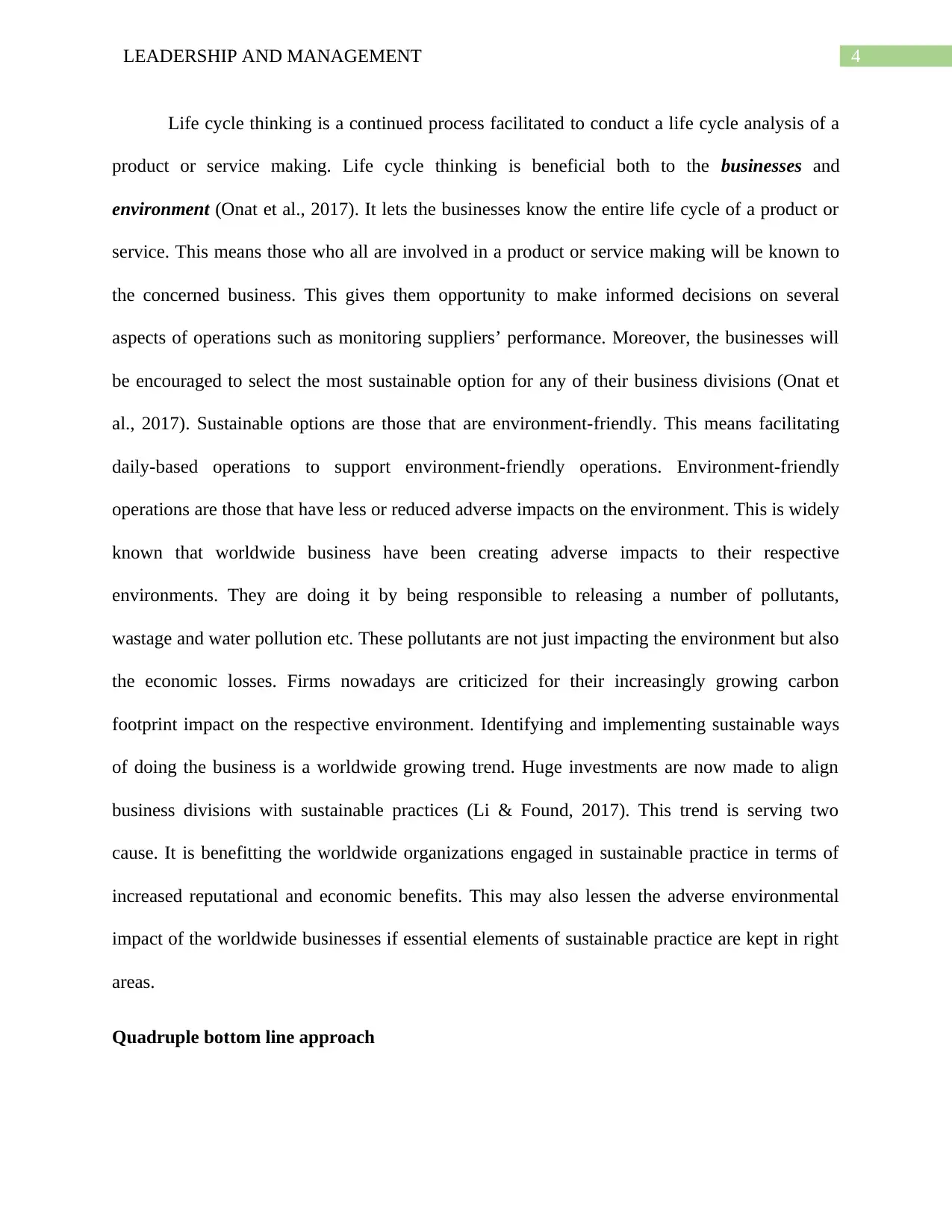
4LEADERSHIP AND MANAGEMENT
Life cycle thinking is a continued process facilitated to conduct a life cycle analysis of a
product or service making. Life cycle thinking is beneficial both to the businesses and
environment (Onat et al., 2017). It lets the businesses know the entire life cycle of a product or
service. This means those who all are involved in a product or service making will be known to
the concerned business. This gives them opportunity to make informed decisions on several
aspects of operations such as monitoring suppliers’ performance. Moreover, the businesses will
be encouraged to select the most sustainable option for any of their business divisions (Onat et
al., 2017). Sustainable options are those that are environment-friendly. This means facilitating
daily-based operations to support environment-friendly operations. Environment-friendly
operations are those that have less or reduced adverse impacts on the environment. This is widely
known that worldwide business have been creating adverse impacts to their respective
environments. They are doing it by being responsible to releasing a number of pollutants,
wastage and water pollution etc. These pollutants are not just impacting the environment but also
the economic losses. Firms nowadays are criticized for their increasingly growing carbon
footprint impact on the respective environment. Identifying and implementing sustainable ways
of doing the business is a worldwide growing trend. Huge investments are now made to align
business divisions with sustainable practices (Li & Found, 2017). This trend is serving two
cause. It is benefitting the worldwide organizations engaged in sustainable practice in terms of
increased reputational and economic benefits. This may also lessen the adverse environmental
impact of the worldwide businesses if essential elements of sustainable practice are kept in right
areas.
Quadruple bottom line approach
Life cycle thinking is a continued process facilitated to conduct a life cycle analysis of a
product or service making. Life cycle thinking is beneficial both to the businesses and
environment (Onat et al., 2017). It lets the businesses know the entire life cycle of a product or
service. This means those who all are involved in a product or service making will be known to
the concerned business. This gives them opportunity to make informed decisions on several
aspects of operations such as monitoring suppliers’ performance. Moreover, the businesses will
be encouraged to select the most sustainable option for any of their business divisions (Onat et
al., 2017). Sustainable options are those that are environment-friendly. This means facilitating
daily-based operations to support environment-friendly operations. Environment-friendly
operations are those that have less or reduced adverse impacts on the environment. This is widely
known that worldwide business have been creating adverse impacts to their respective
environments. They are doing it by being responsible to releasing a number of pollutants,
wastage and water pollution etc. These pollutants are not just impacting the environment but also
the economic losses. Firms nowadays are criticized for their increasingly growing carbon
footprint impact on the respective environment. Identifying and implementing sustainable ways
of doing the business is a worldwide growing trend. Huge investments are now made to align
business divisions with sustainable practices (Li & Found, 2017). This trend is serving two
cause. It is benefitting the worldwide organizations engaged in sustainable practice in terms of
increased reputational and economic benefits. This may also lessen the adverse environmental
impact of the worldwide businesses if essential elements of sustainable practice are kept in right
areas.
Quadruple bottom line approach
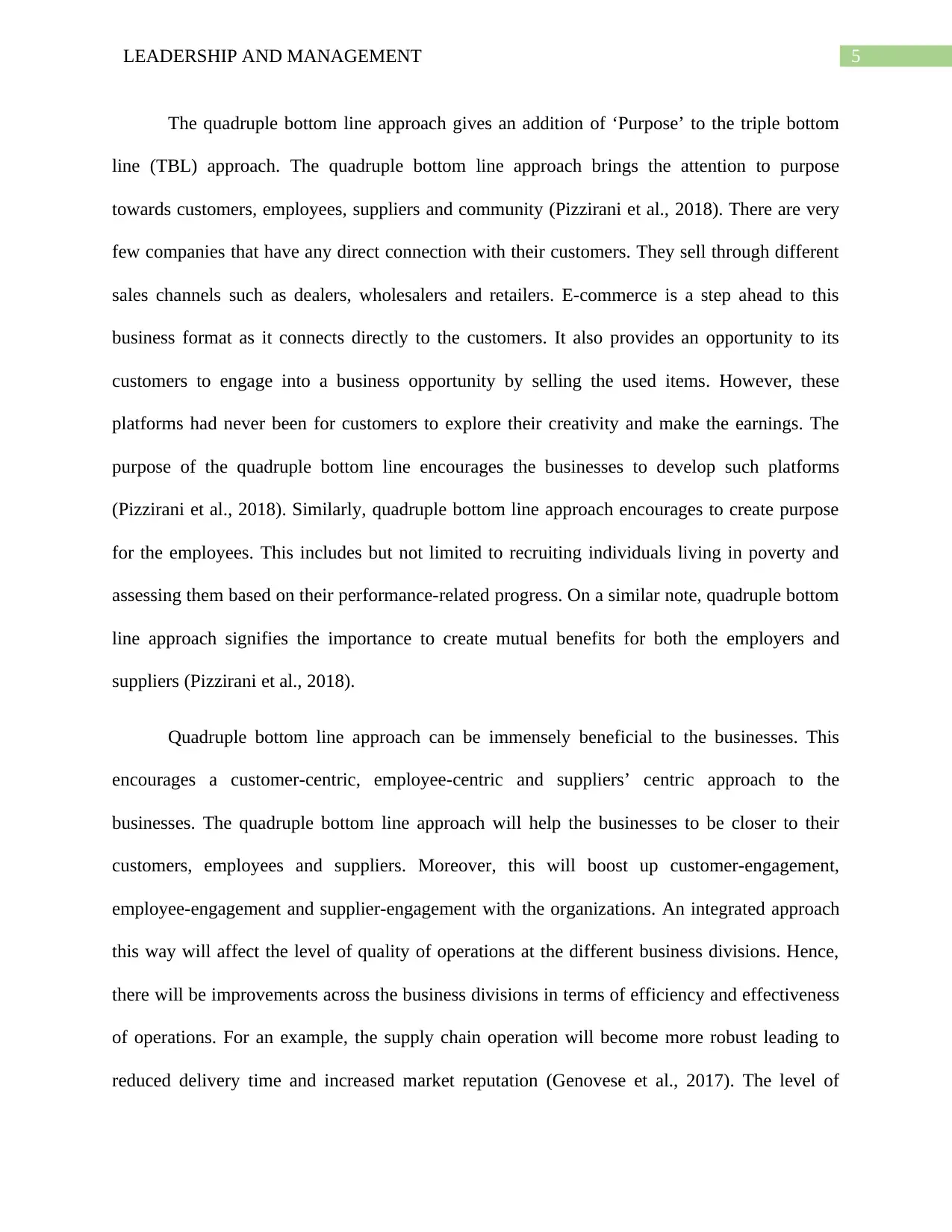
5LEADERSHIP AND MANAGEMENT
The quadruple bottom line approach gives an addition of ‘Purpose’ to the triple bottom
line (TBL) approach. The quadruple bottom line approach brings the attention to purpose
towards customers, employees, suppliers and community (Pizzirani et al., 2018). There are very
few companies that have any direct connection with their customers. They sell through different
sales channels such as dealers, wholesalers and retailers. E-commerce is a step ahead to this
business format as it connects directly to the customers. It also provides an opportunity to its
customers to engage into a business opportunity by selling the used items. However, these
platforms had never been for customers to explore their creativity and make the earnings. The
purpose of the quadruple bottom line encourages the businesses to develop such platforms
(Pizzirani et al., 2018). Similarly, quadruple bottom line approach encourages to create purpose
for the employees. This includes but not limited to recruiting individuals living in poverty and
assessing them based on their performance-related progress. On a similar note, quadruple bottom
line approach signifies the importance to create mutual benefits for both the employers and
suppliers (Pizzirani et al., 2018).
Quadruple bottom line approach can be immensely beneficial to the businesses. This
encourages a customer-centric, employee-centric and suppliers’ centric approach to the
businesses. The quadruple bottom line approach will help the businesses to be closer to their
customers, employees and suppliers. Moreover, this will boost up customer-engagement,
employee-engagement and supplier-engagement with the organizations. An integrated approach
this way will affect the level of quality of operations at the different business divisions. Hence,
there will be improvements across the business divisions in terms of efficiency and effectiveness
of operations. For an example, the supply chain operation will become more robust leading to
reduced delivery time and increased market reputation (Genovese et al., 2017). The level of
The quadruple bottom line approach gives an addition of ‘Purpose’ to the triple bottom
line (TBL) approach. The quadruple bottom line approach brings the attention to purpose
towards customers, employees, suppliers and community (Pizzirani et al., 2018). There are very
few companies that have any direct connection with their customers. They sell through different
sales channels such as dealers, wholesalers and retailers. E-commerce is a step ahead to this
business format as it connects directly to the customers. It also provides an opportunity to its
customers to engage into a business opportunity by selling the used items. However, these
platforms had never been for customers to explore their creativity and make the earnings. The
purpose of the quadruple bottom line encourages the businesses to develop such platforms
(Pizzirani et al., 2018). Similarly, quadruple bottom line approach encourages to create purpose
for the employees. This includes but not limited to recruiting individuals living in poverty and
assessing them based on their performance-related progress. On a similar note, quadruple bottom
line approach signifies the importance to create mutual benefits for both the employers and
suppliers (Pizzirani et al., 2018).
Quadruple bottom line approach can be immensely beneficial to the businesses. This
encourages a customer-centric, employee-centric and suppliers’ centric approach to the
businesses. The quadruple bottom line approach will help the businesses to be closer to their
customers, employees and suppliers. Moreover, this will boost up customer-engagement,
employee-engagement and supplier-engagement with the organizations. An integrated approach
this way will affect the level of quality of operations at the different business divisions. Hence,
there will be improvements across the business divisions in terms of efficiency and effectiveness
of operations. For an example, the supply chain operation will become more robust leading to
reduced delivery time and increased market reputation (Genovese et al., 2017). The level of
⊘ This is a preview!⊘
Do you want full access?
Subscribe today to unlock all pages.

Trusted by 1+ million students worldwide

6LEADERSHIP AND MANAGEMENT
customer satisfaction will also improve leading to increased sales and customer loyalty (Hill &
Brierley, 2017). The supplier-management relationship will get better leading to reduced
communication gaps between suppliers and the employers, improved forecasts of the suppliers’
capacity and reduced wastage (Genovese et al., 2017).
1.2 Analyzing in context to the chosen business
Life cycle thinking in context to ‘Countdown’
Countdown is one of very few companies in New Zealand to have taken part in
‘Sustainability Accelerator Program’. With this participation Countdown is intended to conduct
a diagnostic study of entire plastic packaging system in New Zealand. This study will also
investigate key challenges of adopting a circular economic approach to plastics. At present, the
company is focused on removing unnecessary use of plastics and packaging across its business.
The bottom line is to reduce the company’s plastic pollution impact (Inside Retail, 2019). These
activities that are yet to be implemented by Countdown suggest an initiative being adopted to
enhance the company’s focus on life cycle thinking. The company looks confined not just to
implement a solution but also to reach to the trigger point of the problem. By taking part in the
sustainability accelerator program they are trying to reach to its primary producers, and
understand the nature and behavior of plastics. In addition, the company has also announced its
2025 plan to control the plastic pollution. Countdown pledged to attain 100 percent recyclable,
reusable or compostable packaging specifically in its own brands (Inside Retail, 2019).
Quadruple bottom line approach in context to ‘Countdown’
customer satisfaction will also improve leading to increased sales and customer loyalty (Hill &
Brierley, 2017). The supplier-management relationship will get better leading to reduced
communication gaps between suppliers and the employers, improved forecasts of the suppliers’
capacity and reduced wastage (Genovese et al., 2017).
1.2 Analyzing in context to the chosen business
Life cycle thinking in context to ‘Countdown’
Countdown is one of very few companies in New Zealand to have taken part in
‘Sustainability Accelerator Program’. With this participation Countdown is intended to conduct
a diagnostic study of entire plastic packaging system in New Zealand. This study will also
investigate key challenges of adopting a circular economic approach to plastics. At present, the
company is focused on removing unnecessary use of plastics and packaging across its business.
The bottom line is to reduce the company’s plastic pollution impact (Inside Retail, 2019). These
activities that are yet to be implemented by Countdown suggest an initiative being adopted to
enhance the company’s focus on life cycle thinking. The company looks confined not just to
implement a solution but also to reach to the trigger point of the problem. By taking part in the
sustainability accelerator program they are trying to reach to its primary producers, and
understand the nature and behavior of plastics. In addition, the company has also announced its
2025 plan to control the plastic pollution. Countdown pledged to attain 100 percent recyclable,
reusable or compostable packaging specifically in its own brands (Inside Retail, 2019).
Quadruple bottom line approach in context to ‘Countdown’
Paraphrase This Document
Need a fresh take? Get an instant paraphrase of this document with our AI Paraphraser
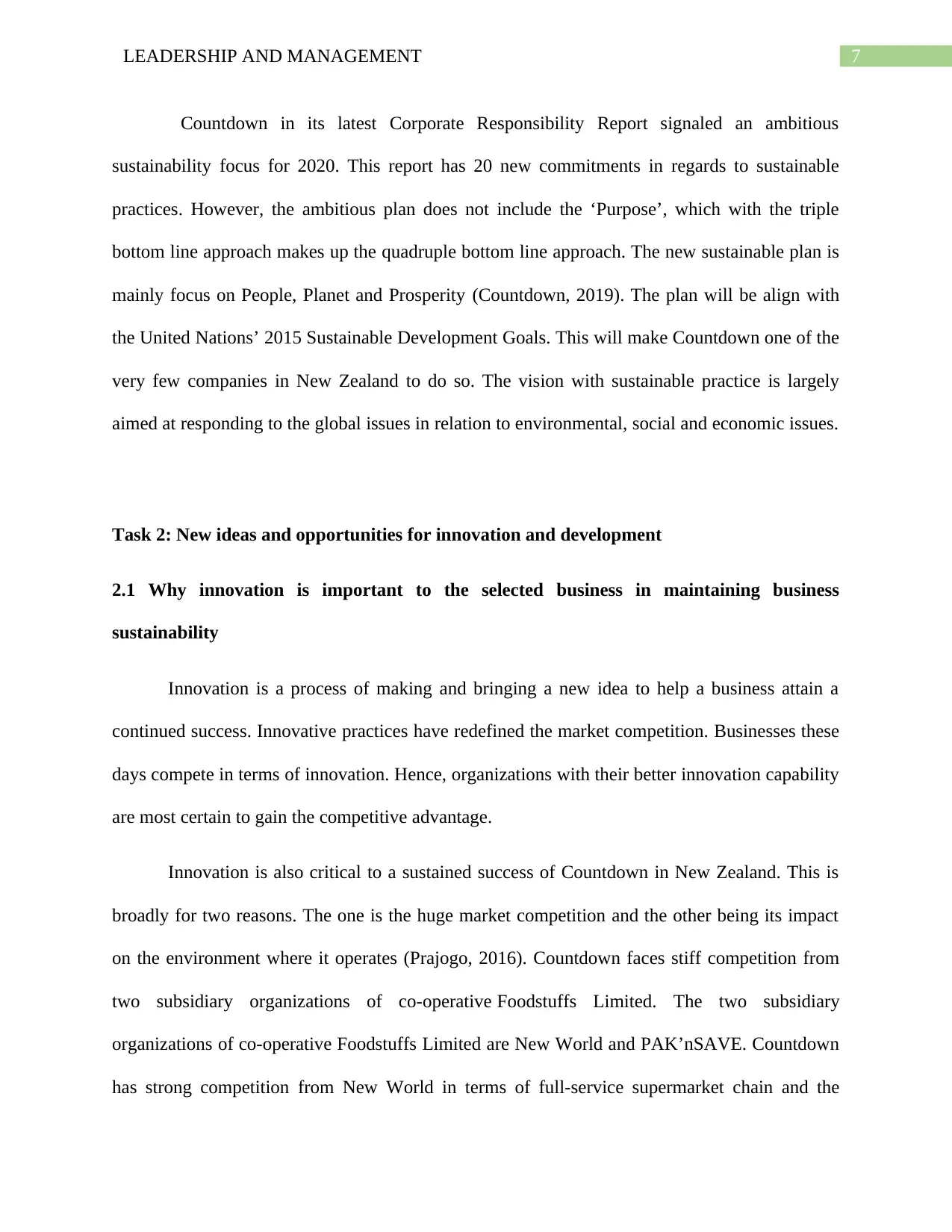
7LEADERSHIP AND MANAGEMENT
Countdown in its latest Corporate Responsibility Report signaled an ambitious
sustainability focus for 2020. This report has 20 new commitments in regards to sustainable
practices. However, the ambitious plan does not include the ‘Purpose’, which with the triple
bottom line approach makes up the quadruple bottom line approach. The new sustainable plan is
mainly focus on People, Planet and Prosperity (Countdown, 2019). The plan will be align with
the United Nations’ 2015 Sustainable Development Goals. This will make Countdown one of the
very few companies in New Zealand to do so. The vision with sustainable practice is largely
aimed at responding to the global issues in relation to environmental, social and economic issues.
Task 2: New ideas and opportunities for innovation and development
2.1 Why innovation is important to the selected business in maintaining business
sustainability
Innovation is a process of making and bringing a new idea to help a business attain a
continued success. Innovative practices have redefined the market competition. Businesses these
days compete in terms of innovation. Hence, organizations with their better innovation capability
are most certain to gain the competitive advantage.
Innovation is also critical to a sustained success of Countdown in New Zealand. This is
broadly for two reasons. The one is the huge market competition and the other being its impact
on the environment where it operates (Prajogo, 2016). Countdown faces stiff competition from
two subsidiary organizations of co-operative Foodstuffs Limited. The two subsidiary
organizations of co-operative Foodstuffs Limited are New World and PAK’nSAVE. Countdown
has strong competition from New World in terms of full-service supermarket chain and the
Countdown in its latest Corporate Responsibility Report signaled an ambitious
sustainability focus for 2020. This report has 20 new commitments in regards to sustainable
practices. However, the ambitious plan does not include the ‘Purpose’, which with the triple
bottom line approach makes up the quadruple bottom line approach. The new sustainable plan is
mainly focus on People, Planet and Prosperity (Countdown, 2019). The plan will be align with
the United Nations’ 2015 Sustainable Development Goals. This will make Countdown one of the
very few companies in New Zealand to do so. The vision with sustainable practice is largely
aimed at responding to the global issues in relation to environmental, social and economic issues.
Task 2: New ideas and opportunities for innovation and development
2.1 Why innovation is important to the selected business in maintaining business
sustainability
Innovation is a process of making and bringing a new idea to help a business attain a
continued success. Innovative practices have redefined the market competition. Businesses these
days compete in terms of innovation. Hence, organizations with their better innovation capability
are most certain to gain the competitive advantage.
Innovation is also critical to a sustained success of Countdown in New Zealand. This is
broadly for two reasons. The one is the huge market competition and the other being its impact
on the environment where it operates (Prajogo, 2016). Countdown faces stiff competition from
two subsidiary organizations of co-operative Foodstuffs Limited. The two subsidiary
organizations of co-operative Foodstuffs Limited are New World and PAK’nSAVE. Countdown
has strong competition from New World in terms of full-service supermarket chain and the
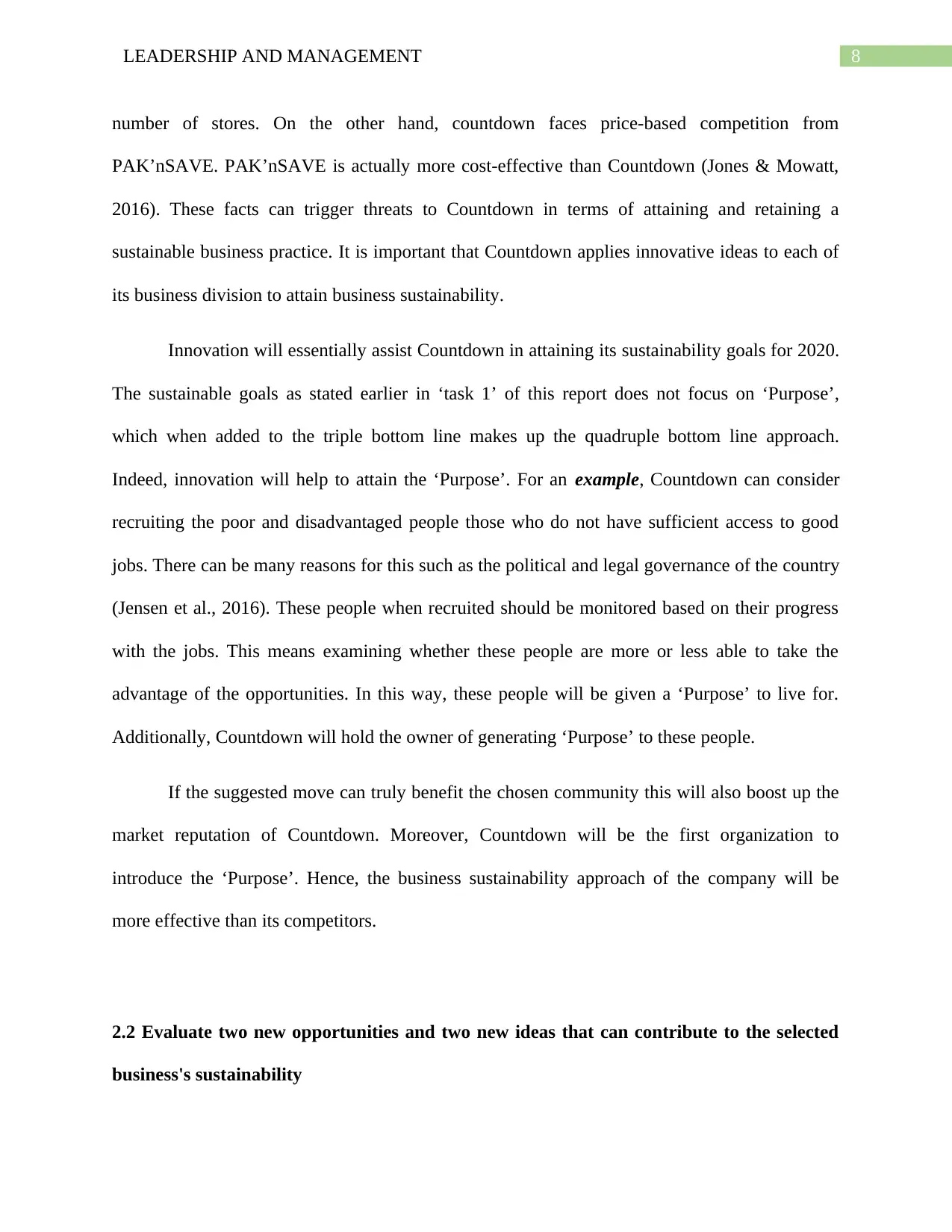
8LEADERSHIP AND MANAGEMENT
number of stores. On the other hand, countdown faces price-based competition from
PAK’nSAVE. PAK’nSAVE is actually more cost-effective than Countdown (Jones & Mowatt,
2016). These facts can trigger threats to Countdown in terms of attaining and retaining a
sustainable business practice. It is important that Countdown applies innovative ideas to each of
its business division to attain business sustainability.
Innovation will essentially assist Countdown in attaining its sustainability goals for 2020.
The sustainable goals as stated earlier in ‘task 1’ of this report does not focus on ‘Purpose’,
which when added to the triple bottom line makes up the quadruple bottom line approach.
Indeed, innovation will help to attain the ‘Purpose’. For an example, Countdown can consider
recruiting the poor and disadvantaged people those who do not have sufficient access to good
jobs. There can be many reasons for this such as the political and legal governance of the country
(Jensen et al., 2016). These people when recruited should be monitored based on their progress
with the jobs. This means examining whether these people are more or less able to take the
advantage of the opportunities. In this way, these people will be given a ‘Purpose’ to live for.
Additionally, Countdown will hold the owner of generating ‘Purpose’ to these people.
If the suggested move can truly benefit the chosen community this will also boost up the
market reputation of Countdown. Moreover, Countdown will be the first organization to
introduce the ‘Purpose’. Hence, the business sustainability approach of the company will be
more effective than its competitors.
2.2 Evaluate two new opportunities and two new ideas that can contribute to the selected
business's sustainability
number of stores. On the other hand, countdown faces price-based competition from
PAK’nSAVE. PAK’nSAVE is actually more cost-effective than Countdown (Jones & Mowatt,
2016). These facts can trigger threats to Countdown in terms of attaining and retaining a
sustainable business practice. It is important that Countdown applies innovative ideas to each of
its business division to attain business sustainability.
Innovation will essentially assist Countdown in attaining its sustainability goals for 2020.
The sustainable goals as stated earlier in ‘task 1’ of this report does not focus on ‘Purpose’,
which when added to the triple bottom line makes up the quadruple bottom line approach.
Indeed, innovation will help to attain the ‘Purpose’. For an example, Countdown can consider
recruiting the poor and disadvantaged people those who do not have sufficient access to good
jobs. There can be many reasons for this such as the political and legal governance of the country
(Jensen et al., 2016). These people when recruited should be monitored based on their progress
with the jobs. This means examining whether these people are more or less able to take the
advantage of the opportunities. In this way, these people will be given a ‘Purpose’ to live for.
Additionally, Countdown will hold the owner of generating ‘Purpose’ to these people.
If the suggested move can truly benefit the chosen community this will also boost up the
market reputation of Countdown. Moreover, Countdown will be the first organization to
introduce the ‘Purpose’. Hence, the business sustainability approach of the company will be
more effective than its competitors.
2.2 Evaluate two new opportunities and two new ideas that can contribute to the selected
business's sustainability
⊘ This is a preview!⊘
Do you want full access?
Subscribe today to unlock all pages.

Trusted by 1+ million students worldwide
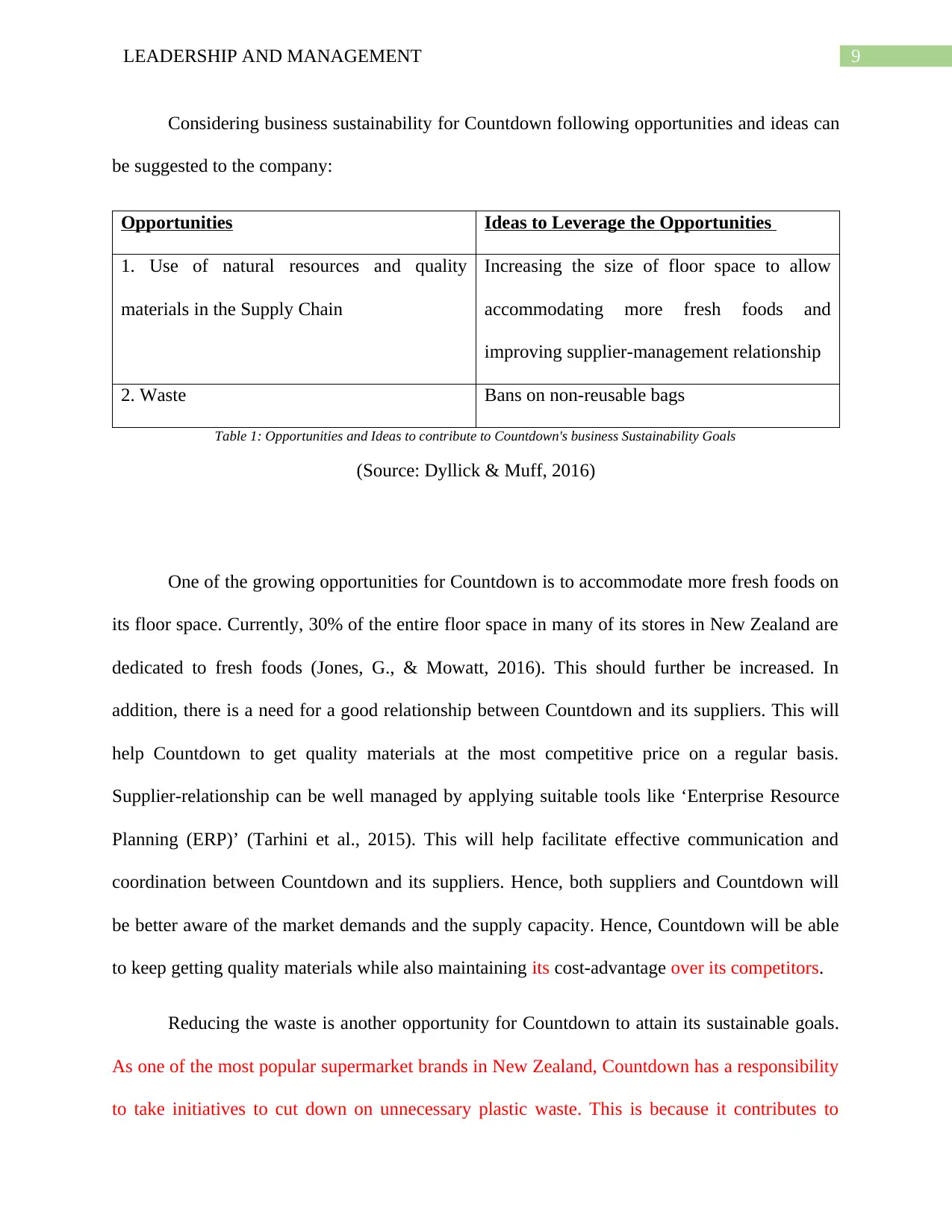
9LEADERSHIP AND MANAGEMENT
Considering business sustainability for Countdown following opportunities and ideas can
be suggested to the company:
Opportunities Ideas to Leverage the Opportunities
1. Use of natural resources and quality
materials in the Supply Chain
Increasing the size of floor space to allow
accommodating more fresh foods and
improving supplier-management relationship
2. Waste Bans on non-reusable bags
Table 1: Opportunities and Ideas to contribute to Countdown's business Sustainability Goals
(Source: Dyllick & Muff, 2016)
One of the growing opportunities for Countdown is to accommodate more fresh foods on
its floor space. Currently, 30% of the entire floor space in many of its stores in New Zealand are
dedicated to fresh foods (Jones, G., & Mowatt, 2016). This should further be increased. In
addition, there is a need for a good relationship between Countdown and its suppliers. This will
help Countdown to get quality materials at the most competitive price on a regular basis.
Supplier-relationship can be well managed by applying suitable tools like ‘Enterprise Resource
Planning (ERP)’ (Tarhini et al., 2015). This will help facilitate effective communication and
coordination between Countdown and its suppliers. Hence, both suppliers and Countdown will
be better aware of the market demands and the supply capacity. Hence, Countdown will be able
to keep getting quality materials while also maintaining its cost-advantage over its competitors.
Reducing the waste is another opportunity for Countdown to attain its sustainable goals.
As one of the most popular supermarket brands in New Zealand, Countdown has a responsibility
to take initiatives to cut down on unnecessary plastic waste. This is because it contributes to
Considering business sustainability for Countdown following opportunities and ideas can
be suggested to the company:
Opportunities Ideas to Leverage the Opportunities
1. Use of natural resources and quality
materials in the Supply Chain
Increasing the size of floor space to allow
accommodating more fresh foods and
improving supplier-management relationship
2. Waste Bans on non-reusable bags
Table 1: Opportunities and Ideas to contribute to Countdown's business Sustainability Goals
(Source: Dyllick & Muff, 2016)
One of the growing opportunities for Countdown is to accommodate more fresh foods on
its floor space. Currently, 30% of the entire floor space in many of its stores in New Zealand are
dedicated to fresh foods (Jones, G., & Mowatt, 2016). This should further be increased. In
addition, there is a need for a good relationship between Countdown and its suppliers. This will
help Countdown to get quality materials at the most competitive price on a regular basis.
Supplier-relationship can be well managed by applying suitable tools like ‘Enterprise Resource
Planning (ERP)’ (Tarhini et al., 2015). This will help facilitate effective communication and
coordination between Countdown and its suppliers. Hence, both suppliers and Countdown will
be better aware of the market demands and the supply capacity. Hence, Countdown will be able
to keep getting quality materials while also maintaining its cost-advantage over its competitors.
Reducing the waste is another opportunity for Countdown to attain its sustainable goals.
As one of the most popular supermarket brands in New Zealand, Countdown has a responsibility
to take initiatives to cut down on unnecessary plastic waste. This is because it contributes to
Paraphrase This Document
Need a fresh take? Get an instant paraphrase of this document with our AI Paraphraser
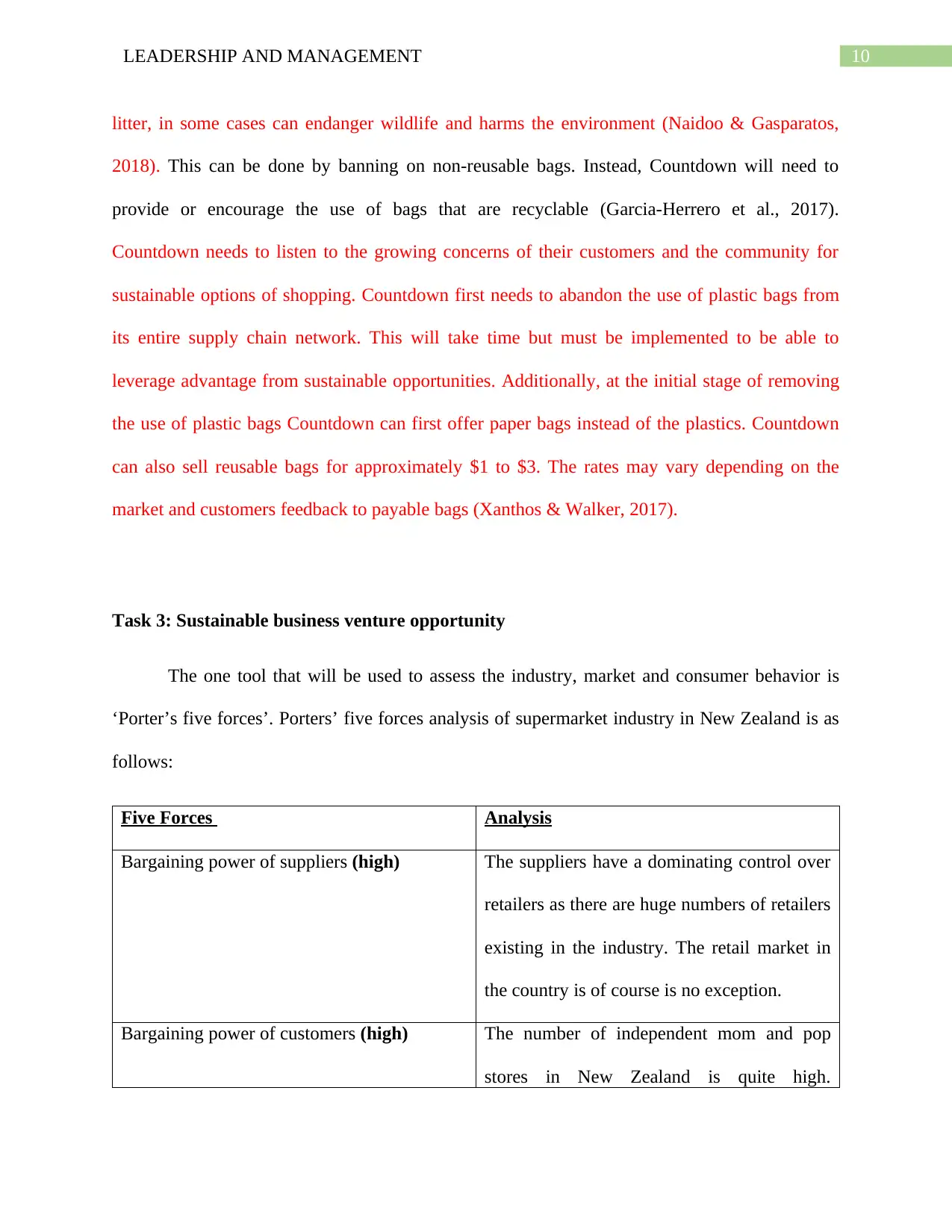
10LEADERSHIP AND MANAGEMENT
litter, in some cases can endanger wildlife and harms the environment (Naidoo & Gasparatos,
2018). This can be done by banning on non-reusable bags. Instead, Countdown will need to
provide or encourage the use of bags that are recyclable (Garcia-Herrero et al., 2017).
Countdown needs to listen to the growing concerns of their customers and the community for
sustainable options of shopping. Countdown first needs to abandon the use of plastic bags from
its entire supply chain network. This will take time but must be implemented to be able to
leverage advantage from sustainable opportunities. Additionally, at the initial stage of removing
the use of plastic bags Countdown can first offer paper bags instead of the plastics. Countdown
can also sell reusable bags for approximately $1 to $3. The rates may vary depending on the
market and customers feedback to payable bags (Xanthos & Walker, 2017).
Task 3: Sustainable business venture opportunity
The one tool that will be used to assess the industry, market and consumer behavior is
‘Porter’s five forces’. Porters’ five forces analysis of supermarket industry in New Zealand is as
follows:
Five Forces Analysis
Bargaining power of suppliers (high) The suppliers have a dominating control over
retailers as there are huge numbers of retailers
existing in the industry. The retail market in
the country is of course is no exception.
Bargaining power of customers (high) The number of independent mom and pop
stores in New Zealand is quite high.
litter, in some cases can endanger wildlife and harms the environment (Naidoo & Gasparatos,
2018). This can be done by banning on non-reusable bags. Instead, Countdown will need to
provide or encourage the use of bags that are recyclable (Garcia-Herrero et al., 2017).
Countdown needs to listen to the growing concerns of their customers and the community for
sustainable options of shopping. Countdown first needs to abandon the use of plastic bags from
its entire supply chain network. This will take time but must be implemented to be able to
leverage advantage from sustainable opportunities. Additionally, at the initial stage of removing
the use of plastic bags Countdown can first offer paper bags instead of the plastics. Countdown
can also sell reusable bags for approximately $1 to $3. The rates may vary depending on the
market and customers feedback to payable bags (Xanthos & Walker, 2017).
Task 3: Sustainable business venture opportunity
The one tool that will be used to assess the industry, market and consumer behavior is
‘Porter’s five forces’. Porters’ five forces analysis of supermarket industry in New Zealand is as
follows:
Five Forces Analysis
Bargaining power of suppliers (high) The suppliers have a dominating control over
retailers as there are huge numbers of retailers
existing in the industry. The retail market in
the country is of course is no exception.
Bargaining power of customers (high) The number of independent mom and pop
stores in New Zealand is quite high.
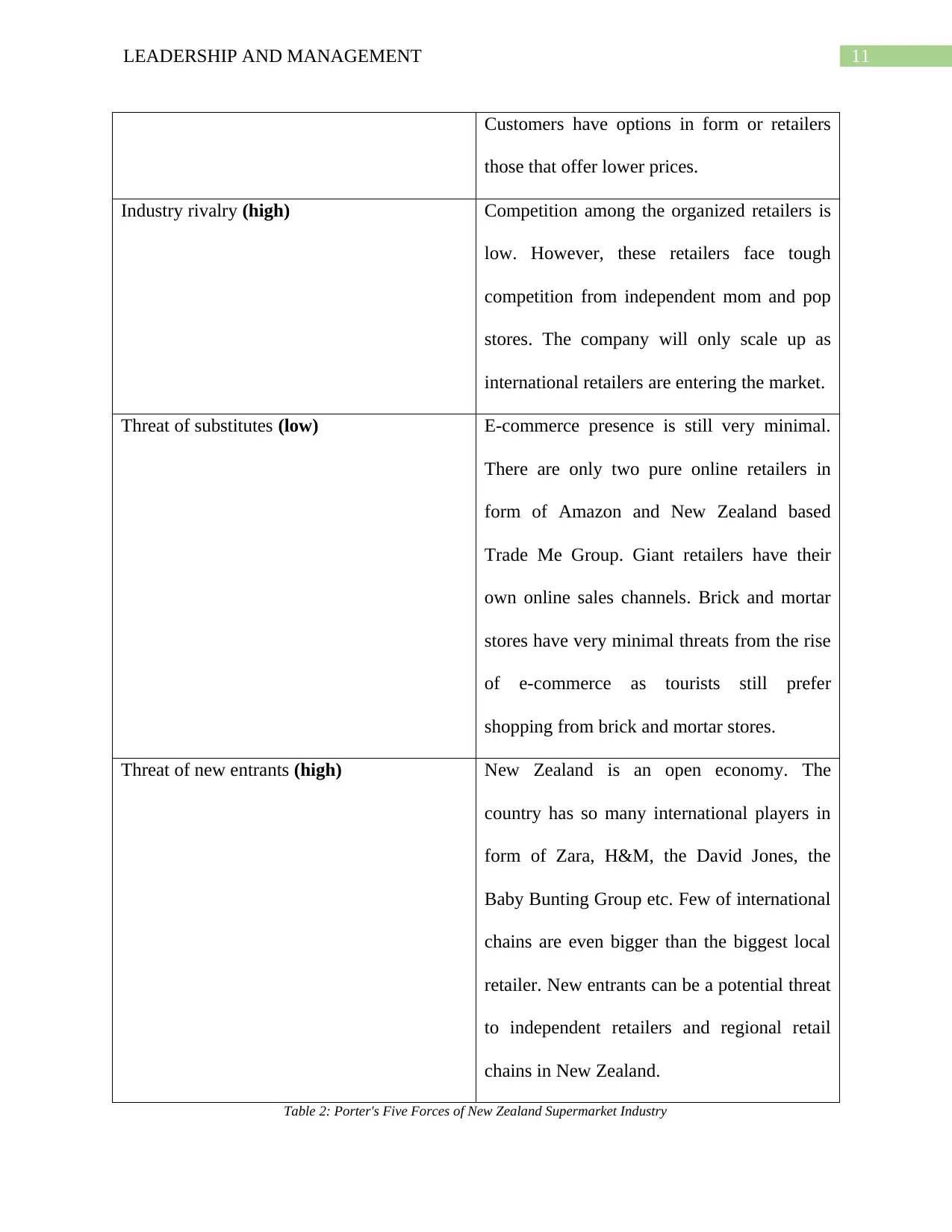
11LEADERSHIP AND MANAGEMENT
Customers have options in form or retailers
those that offer lower prices.
Industry rivalry (high) Competition among the organized retailers is
low. However, these retailers face tough
competition from independent mom and pop
stores. The company will only scale up as
international retailers are entering the market.
Threat of substitutes (low) E-commerce presence is still very minimal.
There are only two pure online retailers in
form of Amazon and New Zealand based
Trade Me Group. Giant retailers have their
own online sales channels. Brick and mortar
stores have very minimal threats from the rise
of e-commerce as tourists still prefer
shopping from brick and mortar stores.
Threat of new entrants (high) New Zealand is an open economy. The
country has so many international players in
form of Zara, H&M, the David Jones, the
Baby Bunting Group etc. Few of international
chains are even bigger than the biggest local
retailer. New entrants can be a potential threat
to independent retailers and regional retail
chains in New Zealand.
Table 2: Porter's Five Forces of New Zealand Supermarket Industry
Customers have options in form or retailers
those that offer lower prices.
Industry rivalry (high) Competition among the organized retailers is
low. However, these retailers face tough
competition from independent mom and pop
stores. The company will only scale up as
international retailers are entering the market.
Threat of substitutes (low) E-commerce presence is still very minimal.
There are only two pure online retailers in
form of Amazon and New Zealand based
Trade Me Group. Giant retailers have their
own online sales channels. Brick and mortar
stores have very minimal threats from the rise
of e-commerce as tourists still prefer
shopping from brick and mortar stores.
Threat of new entrants (high) New Zealand is an open economy. The
country has so many international players in
form of Zara, H&M, the David Jones, the
Baby Bunting Group etc. Few of international
chains are even bigger than the biggest local
retailer. New entrants can be a potential threat
to independent retailers and regional retail
chains in New Zealand.
Table 2: Porter's Five Forces of New Zealand Supermarket Industry
⊘ This is a preview!⊘
Do you want full access?
Subscribe today to unlock all pages.

Trusted by 1+ million students worldwide
1 out of 22
Related Documents
Your All-in-One AI-Powered Toolkit for Academic Success.
+13062052269
info@desklib.com
Available 24*7 on WhatsApp / Email
![[object Object]](/_next/static/media/star-bottom.7253800d.svg)
Unlock your academic potential
Copyright © 2020–2025 A2Z Services. All Rights Reserved. Developed and managed by ZUCOL.




